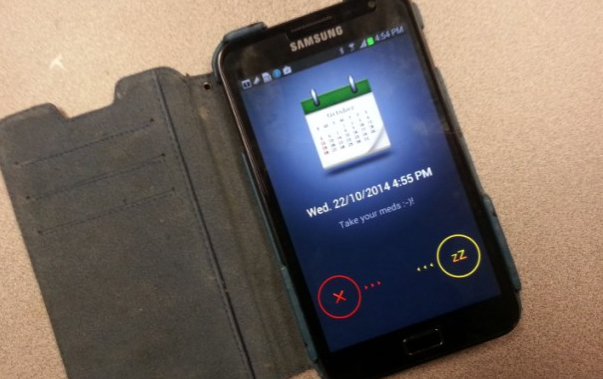
It’s an understatement to say that assistive technology has grown exponentially over the years, and at our October community meeting guest speakers Tracy Milner and Heather Condello, both registered occupational therapists at Complex Injury Rehab Inc, gave us the scoop on how technology can help in the everyday lives of people living with brain injury.
At the meeting, we discussed:
- how to keep up with all the devices and apps that are available
- which devices and apps are best suited to meet the needs of ABI survivors
Smartphones
Smartphones are like computers, and have more functionality than regular cellphones. They have the capacity for:
- email, contacts, calendars
- web browsing
- document management, reminders, notes
- pictures, videos
- apps
- social networking (Facebook, Twitter, Instagram, LinkedIn etc.)
- WiFi
- data plans

Data plans
Data plans cover Internet use on your device, allowing you to do things such as check email, use social media (Facebook, Twitter etc.) and download things when you’re not connected to WiFi. When using data, it is important to be mindful of overage charges (going over your monthly data plan will result in extra charges) and roaming charges (depending on your plan, you may pay extra for data if you are out of town). Accessing WiFi (from home, or a library, coffee shop) does not use any of your data – so it’s best to to download apps or check email when you’re on WiFi. Data plan options include: 3G/4G/LTE and WiFi only (no data plan.) Flex plans and pay-as-you use are also available.
Risks with smartphones
- losing your device – to protect yourself, download a lost phone finder
- breaking your device
- using your phone impulsively
Complex Rehab Inc. has a smartphone selection worksheet to help you decide on which smartphone to buy. They have also created a ‘Day in the life with a smartphone‘ document to demonstrate how using a smartphone can help you with many daily activities when you’re living with a brain injury.

Tablets
In general, tablets are a larger version of the smartphone. They can be purchased without a data plan, or 3G/4G/LTE options. iPad and Android are the most common type of tablets, but others are available, including e-readers. In general, tablets:
- have larger screens than smart phones, from five to 13 inches wide
- have similar capability as smartphones for apps
- are lighter than laptops, and are easier to carry around
- are a more mainstream compensatory strategy
Having said that, tablets also come with some risks. They can be broken or lost (though there are apps to help you find a lost tablet), and some may need support to set up and maintain their tablet. Their screens may also be diffiicult for some to use.
Therapeutic considerations
When choosing a device, it’s important to keep in mind the following:
- size and weight of the device
- touch screen sensitivity
- if typing on a touch screen is difficult, keyboards for tablets can be purchased and are faily low cost
- other accessories which can help with accessibility include stylus options, gloves, switch access and tongue drive systems
- accessibility features include visual and hearing aids, voice control and physical access options such as mounting
- battery life – a good battery is important so you can use your device on the go
- consider where you’ll use the device (wheelchair, bed, table) and make sure the tablet you choose can be used comfortably in these locations
- swing arm mounts can also be helpful

Choosing apps
There are about a zillion apps to chose from – and several kinds which can help with living with the effects of brain injury (see below.) Here are some things to consider when choosing an app:
- look at reviews and screen shots of apps before you download
- once you select an app for download, a password is required
- on an iPhone, you can download multiple apps with one password input over a certain amount of time, but use caution as many apps cost money and you don’t want to be inadvertently charged
- downloading apps is faster when done on WiFi
- pay attention to third-party software – which adds features to already downloaded apps but can also cost money
- Free apps can contain a lot of ads, these can be distracting and are easy to accidentally click on
- Not all apps are available across all devices
BRAINLINE HAS A LIST OF APPS FOR PEOPLE LIVING WITH BRAIN INJURY, WHICH YOU CAN CHECK OUT HERE
Other kinds of technology
There are lots of other technological options than smartphones and tablets, here are some:
Smart homes – have environmental controls such as lighting, home devices, alarm, door, video, and AV controls
SmartTVs – TVs with Internet connectivity
Gaming Consoles – Wii, Xbox, PS4
Roomba – the robot vacuum
Remote control blinds and shades
Smart watches (think of a watch with smartphone capabilities) and smart rings (which are not available in the mass market, but are available through pre-orders if you’re tempted)
Google Glass – wearable glasses with smartphone like abilities and natural language voice command
Sleep monitoring – devices that keep track of how much you’ve slept
Adapted from Tracy Milner’s and Heather Condello’s presentation at the BIST community meeting on October 26th, 2015
OUR NEXT COMMUNITY MEETING WILL BE ON NOVEMBER 23rd; TOPIC: MANAGING EMOTIONS AFTER BRAIN INJURY
Filed under: Community Meetings, Technology + ABI Tagged: apps for brain injury, Complex Rehab Inc., Heather Condello, smart phones, tablets, Technology and ABI, Tracy Milner
![]()





